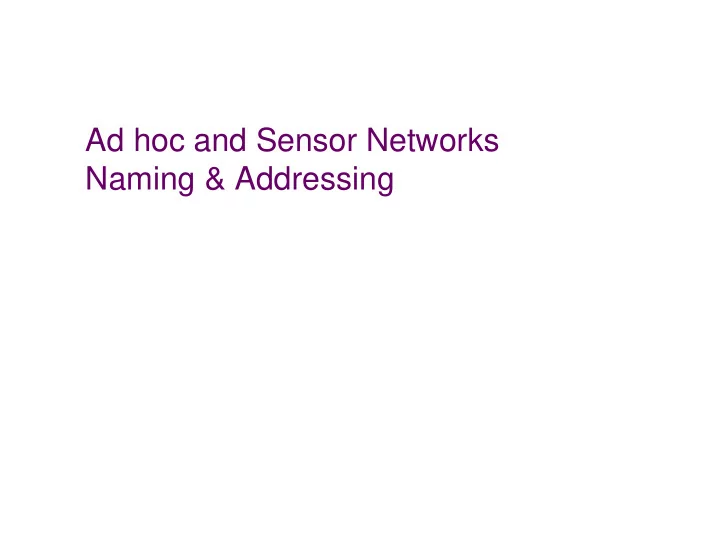

Ad hoc and Sensor Networks Naming & Addressing
Goals of this chapter This short chapter looks at non-standard options for denoting the senders/receivers of messages Traditional (fixed, wireless, ad hoc): Denote individual nodes by their identity WSN: Content-based addresses can be a good complement When addresses are not given a priori, they have to be determined “in the field” Some algorithms are discussed 2
Names vs. addresses Name: Denote/refer to “things” Nodes, networks, data, transactions, … Often, but not always, unique (globally, network-wide, locally) Ad hoc: nodes – WSN: Data! Addresses: Information needed to find these things Street address, IP address, MAC address Often, but not always, unique (globally, network-wide, locally) Addresses often hierarchical, because of their intended use in, e.g., routing protocols Services to map between names and addresses E.g., DNS Sometimes, same data serves as name and address IP addresses are prominent examples 3
Issues in address management Address allocation: Assign an entity an address from a given pool of possible addresses Distributed address assignment (centralized like DHCP does not scale) Address deallocation: Once address no longer used, put it back into the address pool Because of limited pool size Graceful or abrupt, depending on node actions Address representation Conflict detection & resolution ( Duplicate Address Detection ) What to do when the same address is assigned multiple times? Can happen e.g. when two networks merge Binding Map between addresses used by different protocol layers E.g., IP addresses are bound to MAC address by ARP 4
Distributed address assignment Option 1: Let every node randomly pick an address For given size of address space, unacceptable high risk of duplicate addresses (see exercise) Option 2: Avoid addresses used in local neighborhood Option 3: Repair any observed conflicts Temporarily pick a random address from a dedicated pool and a proposed fixed address Send an address request to the proposed address, using temporary address If address reply arrives, proposed address already exists Collisions in temporary address unlikely, as only used briefly Option 4: Similar to 3, but use a neighbor that already has a fixed address to perform requests 5
Content-based addresses Recall: Paradigm change from id-centric to data-centric networking in WSN Supported by content-based names/addresses Do not described involved nodes (not known anyway), but the content itself the interaction is about Classical option: Put a naming scheme on top of IP addresses Done by some middleware systems 6
Content-based addressing: Describe interests Interests describe relevant data/event Used, e.g., by directed diffusion (see later chapter) Nodes match these interests with their locally observed data Format: Attribute-Value-Operation <attribute, value, operation>, e.g.: <TEMP, 20° C, GE> Attributes: temperature, pressure, concentration, … Operations: 7
Matching algorithm Check whether an interest matches the locally available data 8
Geographic addressing Express addresses by denoting physical position of nodes Can be regarded as a special case of content-based addresses Attributes for x and y coordinates (and maybe z) Options Single point Circle or sphere centered around given point Rectangle by two corner points Polygon/polytope by list of points … 9
Conclusion Addresses can be assigned distributedly Non-id-centric addresses give additional expressiveness, enables new interaction patterns than only using standard addresses These addresses have to be supported by specific protocols, in particular, routing protocols 10
Recommend
More recommend